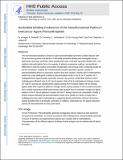| dc.contributor.author | Riddell, Imogen Anne | |
| dc.contributor.author | Johnstone, Timothy | |
| dc.contributor.author | Park, Ga Young | |
| dc.contributor.author | Lippard, Stephen J. | |
| dc.date.accessioned | 2016-08-25T18:55:42Z | |
| dc.date.available | 2016-08-25T18:55:42Z | |
| dc.date.issued | 2016-05 | |
| dc.date.submitted | 2016-04 | |
| dc.identifier.issn | 09476539 | |
| dc.identifier.uri | http://hdl.handle.net/1721.1/103993 | |
| dc.description.abstract | The monofunctional platinum anticancer agent phenanthriplatin generates covalent adducts with the purine bases guanine and adenine. Preferential nucleotide binding was investigated by using a polymerase stop assay and linear DNA amplification with a 163-base pair DNA double helix. Similarly to cisplatin, phenanthriplatin forms the majority of adducts at guanosine residues, but significant differences in both the number and position of platination sites emerge when comparing results for the two complexes. Notably, the monofunctional complex generates a greater number of polymerase-halting lesions at adenosine residues than does cisplatin. Studies with 9-methyladenine reveal that, under abiological conditions, phenanthriplatin binds to the N1 or N7 position of 9-methyladenine in approximately equimolar amounts. By contrast, comparable reactions with 9-methylguanine afforded only the N7-bound species. Both of the 9-methyladenine linkage isomers (N1 and N7) exist as two diastereomeric species, arising from hindered rotation of the aromatic ligands about their respective platinum–nitrogen bonds. Eyring analysis of rate constants extracted from variable-temperature NMR spectroscopic data revealed that the activation energies for ligand rotation in the N1-bound platinum complex and the N7-linkage isomers are comparable. Finally, a kinetic analysis indicated that phenanthriplatin reacts more rapidly, by a factor of eight, with 9-methylguanine than with 9-methyladenine, suggesting that the distribution of lesions formed on double-stranded DNA is kinetically controlled. In addition, implications for the potent anticancer activity of phenanthriplatin are discussed herein. | en_US |
| dc.description.sponsorship | National Cancer Institute (U.S.) (NCI. Grant Number: CA034992) | en_US |
| dc.language.iso | en_US | |
| dc.publisher | John Wiley & Sons | en_US |
| dc.relation.isversionof | http://dx.doi.org/10.1002/chem.201600236 | en_US |
| dc.rights | Creative Commons Attribution-Noncommercial-Share Alike | en_US |
| dc.rights.uri | http://creativecommons.org/licenses/by-nc-sa/4.0/ | en_US |
| dc.source | PMC | en_US |
| dc.title | Nucleotide Binding Preference of the Monofunctional Platinum Anticancer-Agent Phenanthriplatin | en_US |
| dc.type | Article | en_US |
| dc.identifier.citation | Riddell, Imogen A., Timothy C. Johnstone, Ga Young Park, and Stephen J. Lippard. "Nucleotide Binding Preference of the Monofunctional Platinum Anticancer-Agent Phenanthriplatin." Chemistry: A European Journal 22:22 (May 23, 2016), pp. 7574-7581. | en_US |
| dc.contributor.department | Massachusetts Institute of Technology. Department of Chemistry | en_US |
| dc.contributor.mitauthor | Riddell, Imogen Anne | en_US |
| dc.contributor.mitauthor | Johnstone, Timothy | en_US |
| dc.contributor.mitauthor | Park, Ga Young | en_US |
| dc.contributor.mitauthor | Lippard, Stephen J. | en_US |
| dc.relation.journal | Chemistry - A European Journal | en_US |
| dc.eprint.version | Author's final manuscript | en_US |
| dc.type.uri | http://purl.org/eprint/type/JournalArticle | en_US |
| eprint.status | http://purl.org/eprint/status/PeerReviewed | en_US |
| dspace.embargo.terms | N | en_US |
| dc.identifier.orcid | https://orcid.org/0000-0002-6801-0198 | |
| dc.identifier.orcid | https://orcid.org/0000-0002-2693-4982 | |
| mit.license | OPEN_ACCESS_POLICY | en_US |
